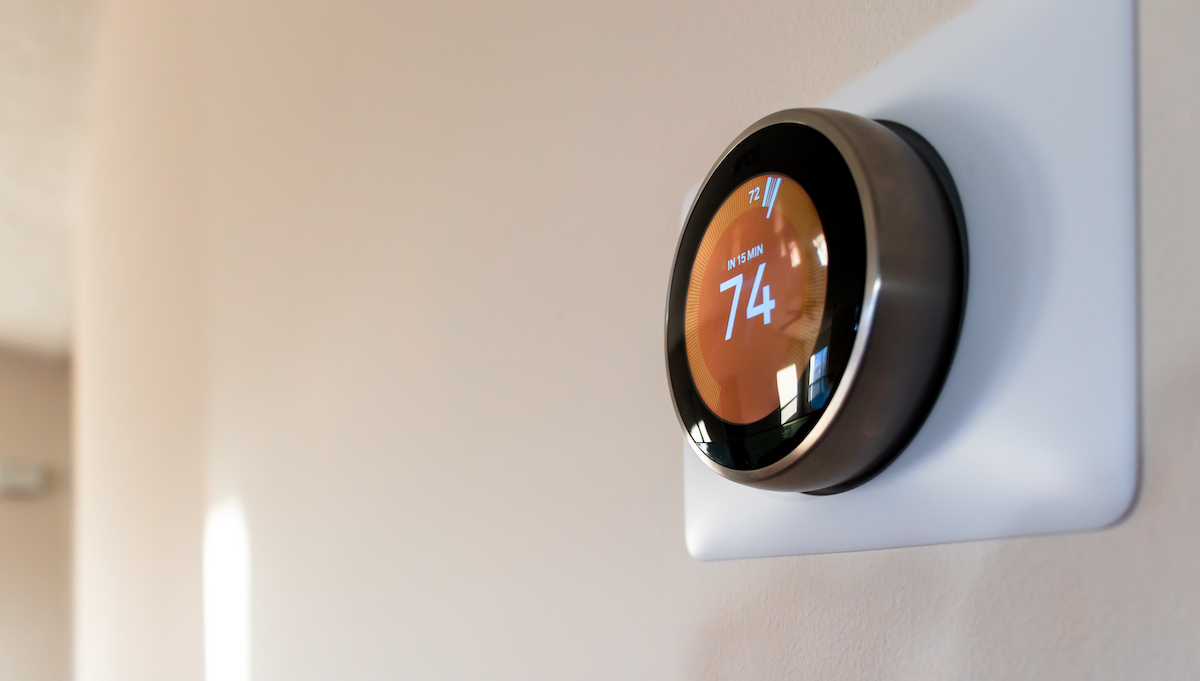Updated 3 months ago
5 best smart thermostats of 2025
Written by Catherine Lane Catherine LaneCatherine has been researching and reporting on the solar industry for five years and is the Written Content Manager at SolarReviews. She leads a dyna...Learn more , Edited by Gianna Cappuccio Gianna CappuccioGianna Cappuccio is an editor at SolarReviews. After obtaining a Bachelor's in English from Montclair State University in 2016, Gianna decided to purs...Learn more

Why you can trust SolarReviews
SolarReviews is the leading American website for solar panel reviews and solar panel installation companies. Our industry experts have a combined three decades of solar experience and maintain editorial independence for their reviews. No company can pay to alter the reviews or review scores shown on our site. Learn more about SolarReviews and how we make money.
Shopping for a smart thermostat can be overwhelming. There are a lot of things to consider, such as what features you want, what style you like, and whether a smart thermostat is compatible with your home.
We took a look at some of the most popular smart thermostats on the market and found the 5 best smart thermostats based on their features and price to help make your shopping a little easier.
*All prices are accurate at the time of this writing.
What is a smart thermostat?
Smart thermostats are the newest way to control the climate of your home and upgrade your home automation ecosystem.
Just like a traditional thermostat, a smart thermostat connects to your HVAC system to change the temperature of a room. However, smart thermostats have a long list of advanced features that theoretically allow you to conserve energy and save money on your electric bill.
With most smart thermostats, you are able to program your schedule into them so the temperature of your home is a little cooler (or warmer, depending on the season) when you’re not home, and just right when you walk through the door.
What makes smart thermostats different from traditional programmable thermostats is that they have the ability to learn your behavior and adjust the temperature of your home based on your habits to save you more energy. Plus, they can usually be easily adjusted through mobile apps on your phone. This allows you to save even more on your electric bill.
5 best smart thermostats of 2025
The best smart thermostat for your home depends on what is most important to you. Is it smart home integration? Are you on a tight budget?
We’ve laid out the best smart thermostats no matter what your needs are.
1. Nest Learning Thermostat

The Nest Learning Thermostat is best-known for its advanced learning capabilities. Image source: Home Depot
Price: $249.00 Buy Now
Best: Overall
Features: The Nest Learning Thermostat 3rd-generation earns the title of best overall smart thermostat for a few reasons. One of the biggest factors that puts the Google Nest Learning Thermostat above the rest is its advanced learning feature.
With advanced learning algorithms and geofencing, your thermostat learns your habits to create a fine-tuned heating and cooling schedule that’s just right for you after just a few days. Now that’s smart!
The Nest Learning Thermostat is also known for being the most stylish smart thermostat. With seven different colors to choose from and a stainless steel rim, there is bound to be a Nest that fits your home’s look. It also has a simplistic display, making it more aesthetically pleasing than some other brands.
The downside is that the Nest is not compatible with all smart home setups. So, if you’re looking to have a Google Home smart hub, the Nest is perfect. But if you have an Apple HomeKit setup, a Nest will not be compatible. And while it doesn’t come with additional sensors, Nest temperature sensors can be purchased separately.
2. ecobee 4 SmartThermostat Premium
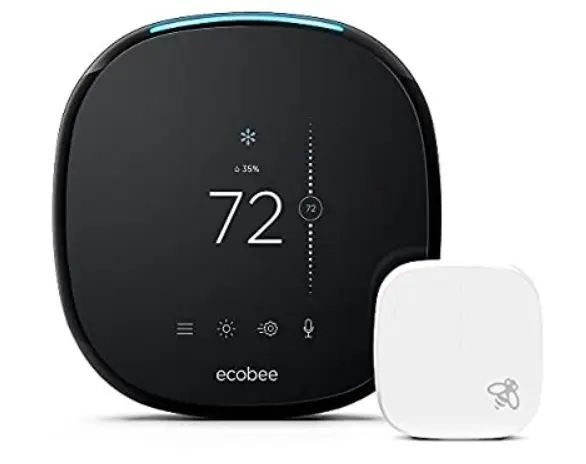
The ecobee SmartThermostat Premium is great for integrating into a smart home and is especially beneficial if you live in an area with Time of Use electricity rates. Image source: ecobee
Price: $249.99 Buy Now
Best: Smart home integration
Features: If you’re looking to integrate a smart thermostat into your smart home, or you want to make your house smarter in the future, the Energy Star-rated ecobee SmartThermostat with voice control is right for you. The SmartThermostat is compatible with most popular smart home systems, like Apple HomeKit, Amazon Alexa, Samsung SmartThings, and IFTTT.
What makes the SmartThermostat really unique is its ability to adjust how it heats your home based on the price of electricity thanks to its eco+ feature. If you live in an area with Time of Use (TOU) electricity rates, this can save you a lot of money. The thermostat will learn when energy is the cheapest, and turn your heat or air conditioner on during that time, saving you money.
Unfortunately, the SmartThermosat does not have advanced learning abilities. This means it relies more heavily on the schedule you input into the system. However, it does come with additional sensors, which allow for better control of the temperature in each room of your house.
It also has a geofencing feature, so it can adjust the temperature when you’re not home to save you money.
A huge bonus for the SmartThermostat is that it comes with an Amazon Alexa or Siri voice assistant built in that allows you to change your temperature settings with the sound of your voice, and works with smart devices you already have. Your thermostat can serve as a smart speaker, an intercom, and even make phone calls. That’s two smart home devices for the price of one!
3. Honeywell Lyric T5+
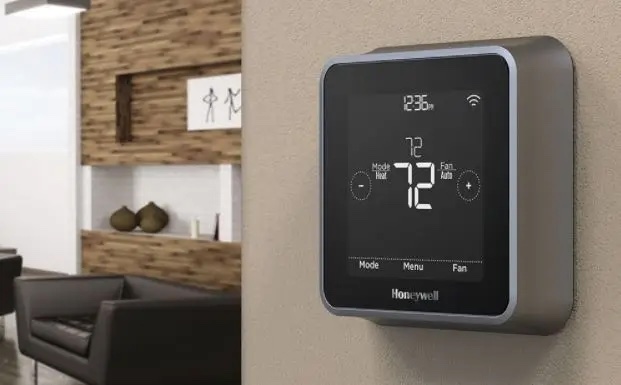
The Honeywell Lyric T5+ is the best smart thermostat if you’re on a budget. Image source: Honeywell
Price: $149.00 Buy Now
Best: Budget thermostat
Features: The Honeywell Lyric T5+ doesn’t have as many features as some of the other smart thermostats on this list, but it comes in at a great price point for what it does offer.
The Honeywell Lyric T5 WiFi thermostat has a geofencing feature that will adjust the temperature of your house when it detects you're not home to save electricity. You can easily adjust what the temperatures will be by changing your “Home” and “Away” settings.
If you don’t want to use their geofencing feature, you can always opt to just have it programmed with your schedule, like a traditional programmable thermostat. However, the touch screen makes it much easier to use than a normal programmable thermostat.
You also have the power to pause your schedule. So, if you’re having a party at your house and you don’t want to adjust all of your settings for the week, simply pause your schedule and adjust the temperature exactly how you want it.
The Honeywell Lyric T5 doesn’t have advanced learning capabilities. The look of it is a little outdated, as well.
However, its reliable geofencing and the ability to program your schedule is great if you're looking for a smart thermostat that can do the basics, without breaking the bank.
4. Nest Thermostat
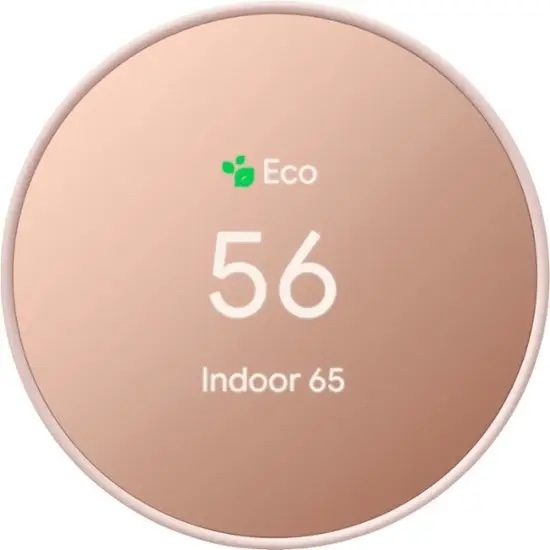
The Nest Thermostat gives you the biggest bang for your buck. Image source: Best Buy
Price: $129.99 Buy Now
Best: Value
Features: Replacing the previous Nest Thermostat E, the new Nest Thermostat has a sleek design at a low price point - giving you the most bang for your buck. The Nest Thermostat has many of the same functionality as its more expensive version, just in different packaging.
Google was able to cut the price down by eliminating the signature moving wheel around the outside of the thermostat. Instead, it was replaced with a touch strip that allows you to adjust the temperature. It also runs on AAA batteries instead of a built-in rechargeable battery.
This Nest Thermostat has many of the advanced features you want from a smart thermostat, without some of the extra frills that inflate the price tag.
5. Mysa Smart Thermostat
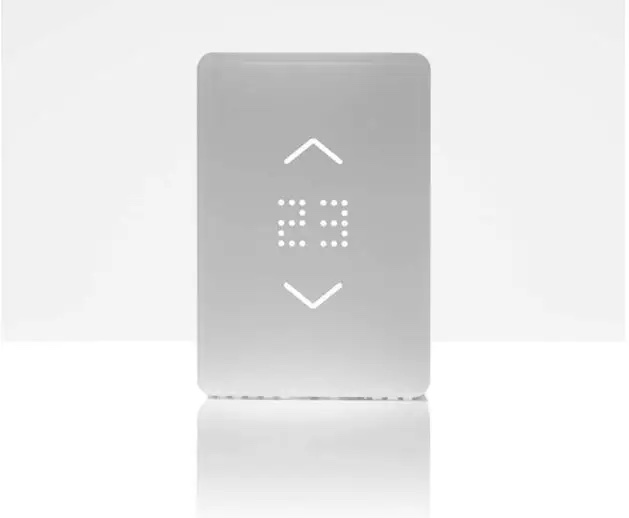
Mysa Smart Thermostat is great if you have baseboard heating. Image source: Amazon
Price: $139.00 Buy Now
Best: High voltage smart thermostat
Features: Many of the more common smart thermostats are not compatible with baseboard heaters - and that’s what makes the Mysa Smart Thermostat stand out. It allows homeowners with high-voltage heating to move into the 21st century. It’s also compatible with Alexa, Google Assistant, and Apple HomeKit.
Mysa’s thermostat has a geolocation feature to adjust the temperature when you’re not home. You can also set it to vacation mode when you won’t be home for extended periods of time. Plus, the thermostat has a pretty sleek design!
What smart thermostat features should you look for?
Not all smart thermostats are created equal and the models on the market all have a variety of different features. Here are a few that you should look out for when buying a smart thermostat:
Whether or not it’s compatible with your HVAC system
Your home’s wiring
Smart home integration
Geofencing and remote sensors
Advanced learning capabilities
Compatibility with your HVAC system
If you have separate cooling and heating systems, you might have to install an individual smart thermostat for each one.
Similarly, if you currently have an individual thermostat in each room, also known as a zoned system, you might need more than one smart thermostat. This could get a little costly, and a regular programmable thermostat could be better for you.
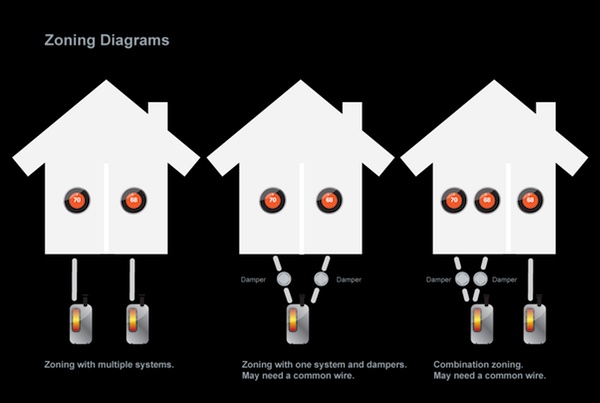
Zoned systems could require multiple smart thermostats to operate properly. Image source: Google Support
Many popular smart thermostat models cannot be used for homes that utilize baseboard heat, or other high-voltage heating and cooling systems. You also need to make sure the smart thermostat is compatible with heat pumps if you do not have a furnace.
There are some brands of smart thermostats made specifically for these types of systems, so keep that in mind when you’re looking to upgrade your thermostat.
The wiring of your home
This is one of the most important things to look for when buying a smart thermostat.
If you take a look at your existing thermostat, you can see what kind of wiring you have. Most smart thermostats require what is known as a C-wire, or common wire, which provides continuous power so your smart thermostat can show its screen display and stay connected to your home WiFi.
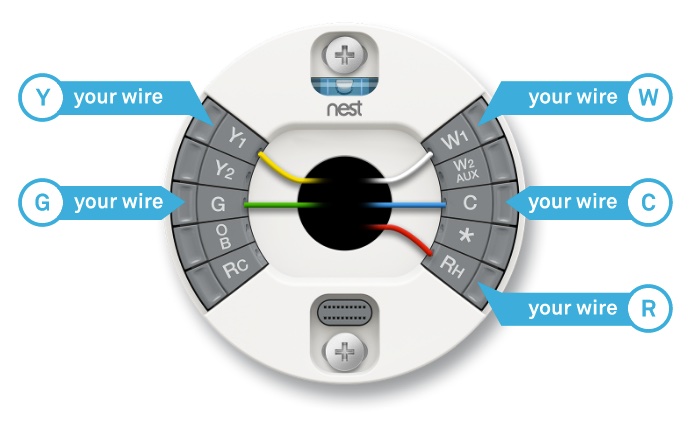
Some smart thermostats require a C-wire. Others have kits to connect to your heating and cooling system if you don’t have a C-wire. Image source: Google Support
Smart home integration
If you have a smart home, or are looking to make your house smarter in the future, smart home integration is extremely important - and not all smart thermostats are compatible with all smart home setups.
For example, the ecobee 4 Smart Thermostat can connect to Apple HomeKit, while the Nest Learning Thermostat cannot.
Some smart thermostats are able to pair with your smart home security system. Both Nest and ecobee thermostats include motion sensors that can be integrated with smart security cameras and alarms to increase your home’s security.
Geofencing and sensors
One of the more advanced features that you’ll see for smart thermostats is geofencing.
With geofencing, your thermostat can set up a perimeter around your home. By connecting to your smartphone, the thermostat will be able to detect when you leave or enter that perimeter.
It can then adjust the temperature to use less energy when you leave the perimeter, and make it just the right temperature when you are within it.
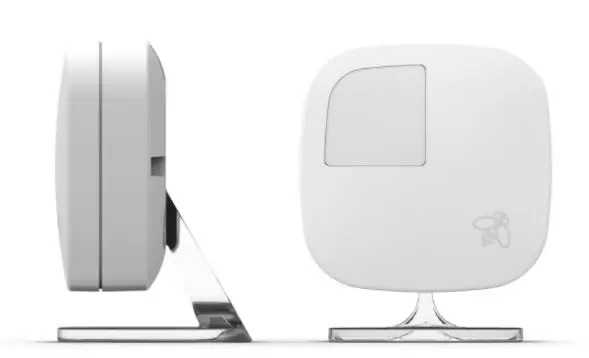
The ecobee comes with room sensors to better regulate the temperature of your home. Image source: ecobee
Some smart thermostats also have smart sensors that you can place throughout your home to better regulate the temperature of your house. These sensors cannot only help heat cool spots in your home, they can also detect motion.
So if there is no motion sensed in a room for a duration of time, the thermostat will adjust the temperature of that room to use less electricity.
Advanced learning
Smart thermostats with advanced learning capabilities take “smart” to the next level.
When a thermostat has an advanced learning feature, it can learn your habits and schedule. Then, it can make a heating and cooling schedule that is based around your everyday life.
For example, let’s say you set your initial schedule to have your home’s temperature at 70 degrees at 5:00 PM, but your thermostat recognizes that you don’t come home until 5:15 PM.
The thermostat will adjust itself to have your home at the perfect temperature at 5:15 PM, saving you some extra electricity in those 15 minutes.
How much can a smart thermostat save you on your electric bill?
We know how smart thermostats can heat and cool your home in a way that saves you electricity - but what savings could you actually get from installing one?
Nest conducted a study in 2015 that found smart thermostat users saved between 10% to 12% on their heating costs, and 15% on their cooling costs.
Let’s say you spend $435 every year on heating costs, and $195 on cooling costs with a regular thermostat. Based on Nest’s study, a smart thermostat would save you about $47.85 on heating and $29.25 on cooling, for a total annual energy savings of $77.10. This adds up over time!
However, you will only see these kinds of savings if you use your smart thermostat properly and you have the right living habits. It can take a lot of work and dedication to get your smart thermostat settings just right in order to save money.
If you want to see even bigger savings on your electric bill, consider installing solar panels.
Solar panels have the potential to wipe out your entire electric bill. Plus, if your utility offers net metering, they will pay you for excess electricity your solar panels produce that your home doesn’t use.
With a smart thermostat cutting down your electricity usage, you’ll have more solar electricity to sell back to your utility! Making energy efficiency upgrades, like a smart thermostat, along with installing solar panels, is a surefire way to get your electric bill lower than you’ve ever seen it!
Do you really need a smart thermostat?
In our opinion, a smart thermostat isn’t a necessary purchase. For one thing, you aren’t guaranteed any savings. In order to actually see a difference on your electric bill, you have to really know what you’re doing when programming your thermostat and keep monitoring it regularly.
Even then, your habits might not lend you to getting any savings. If you already choose to layer on extra blankets instead of turning the heat up, a smart thermostat isn’t really going to matter that much in terms of energy savings - you’re already decreasing energy usage by adding some layers.
You also probably won’t save much if you have someone in your house all day. The main way smart thermostats are supposed to save you money is by making the temperature of your house a little too hot or cold while it’s empty to reduce the amount of heat or air conditioning you use. If someone is home all day, which is more common now with more jobs being remote, there won’t be a time for your smart thermostat to let the temperature get uncomfortable and save you money.
So, unless you are very adamant about keeping up with your smart thermostat schedule, and your habits line up with exactly what is needed to really see some savings, a smart thermostat isn’t really necessary.
You can see similar electric bill savings by using a cheaper, traditional programmable thermostat or by making other energy-efficient upgrades to your home.
Key takeaways
jamie.smith@solarreviews.com
Smart thermostats are thermostats that can connect to your home WiFi and can be controlled through your phone, tablet, or other devices.
You can program smart thermostats according to your schedule to get your home to the perfect temperature, all while saving money on your electricity bills.
Before you purchase a smart thermostat, you need to make sure that it is compatible with your HVAC system, your home’s wiring, and your smart home setup (if you have one).
When used properly, smart thermostats can save homeowners between 10% and 12% on their heating costs and 15% on their cooling costs.
Catherine has been researching and reporting on the solar industry for five years and is the Written Content Manager at SolarReviews. She leads a dynamic team in producing informative and engaging content on residential solar to help homeowners make informed decisions about investing in solar panels. Catherine’s expertise has garnered attention from leading industry publications, with her work being featured in Solar Today Magazine and Solar ...
Learn more about Catherine Lane